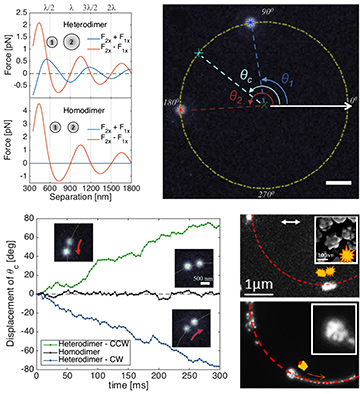 Top left: Simulation of optically induced force of dimers of Ag nanoparticles. The net force changes sign with particle separation. Top right: Dark-field microscope image of 2 Ag NPs in an optical ring trap. Bottom left: Experimentally measured motion of heterodimer and homodimer; heterodimer motion is toward the larger particle. Bottom right: Experimentally observed motion of our asymmetric structures, Au nanostar dimer (top) and Ag nanoparticle cluster (bottom) in a ring trap (see videos). [Enlarge figure]
Top left: Simulation of optically induced force of dimers of Ag nanoparticles. The net force changes sign with particle separation. Top right: Dark-field microscope image of 2 Ag NPs in an optical ring trap. Bottom left: Experimentally measured motion of heterodimer and homodimer; heterodimer motion is toward the larger particle. Bottom right: Experimentally observed motion of our asymmetric structures, Au nanostar dimer (top) and Ag nanoparticle cluster (bottom) in a ring trap (see videos). [Enlarge figure]
Recent theoretical work demonstrated that broken symmetry in pairs of dissimilar nanoparticles trapped in an optical field will result in asymmetric scattering and in motion of the pair in a direction perpendicular to the incident light’s propagation direction.1,2 We recently observed this predicted directed motion in experiments, a development that forms a basis for optically controlled nanomotors.3
In an optical field, numerical calculations suggest that conservation of momentum in the combined nanoparticle–field system causes an asymmetric heterodimer, two electrodynamically bound particles of dissimilar size, to move in a directed fashion toward the larger particle, when separated by a distance of one wavelength. Conversely, a trapped homodimer of two identical bound particles will not experience a net force in the transverse direction.
In our work, we observed the predicted directed motion on heterodimers composed of Ag nanoparticles of 150 and 200 nm, trapped in an optical ring with no driving force.3 When we trapped a homodimer, we observed only Brownian motion of the bound pair. When a heterodimer was trapped, however, we saw directed motion toward the large particle, regardless of dimer orientation. Furthermore, the net force on the heterodimer, and hence the direction of motion, depended on the interparticle separation; when the particles were separated by distances of half-integer wavelengths, the motion was toward the smaller particle, a behavior that matched theoretical predictions.
We further generalized the asymmetric scattering-induced directed motion to inherently asymmetric structures such as Au nanostars and Ag nanoparticle clusters. In these experiments, we used linear polarization to eliminate the effects of rapid rotation. In both cases, we observed strongly driven motion, the direction of which varied with the orientation of the structures.
The putatively "nonreciprocal" motion of asymmetric optically bound nanoparticle arrays demonstrates that forces and torques can be controlled on the nanoscale via engineering of the field scattered from optically trapped structures. These nanostructures can be used as the foundation for optically controlled nanomotors, with further control achievable by chemically or optically engineering the nanoparticle interactions and interparticle separation. Such nanomotors are expected to be important for many applications, ranging from biological sensing to materials science.4
Researchers
Yuval Yifat, Curtis W. Peterson, John Parker, Stuart A. Rice and Norbert F. Scherer, The University of Chicago, Chicago, Ill., USA
Delphine Coursault, Université de Bordeaux, CNRS LOMA, Talence, France
Ying Bao, Western Washington University, Bellingham, Wash., USA
Stephen K. Gray, Argonne National Laboratory, Lemont, Ill., United States.
References
1. S. Sukhov et. al. Opt. Express 23, 247 (2015).
2. V. Karásek, et. al. Opt. Lett. 42, 1436 (2017).
3. Y. Yifat, et. al. Light Sci. Appl. 7, 105 (2018).
4. L. Xu, et. al. Chem. Soc. Rev. 46, 6905 (2017).

